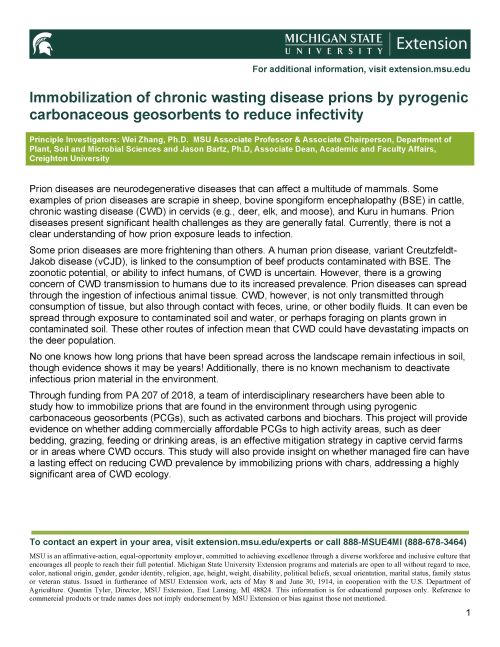Immobilization of CWD Prions
A team of interdisciplinary researchers have been able to study how to immobilize prions that are found in the environment through using pyrogenic carbonaceous geosorbents (PCGs), such as activated carbons and biochars.

Prion diseases are neurodegenerative diseases that can affect a multitude of mammals. Some examples
of prion diseases are scrapie in sheep, bovine spongiform encephalopathy (BSE) in cattle, chronic
wasting disease (CWD) in cervids (e.g., deer, elk, and moose), and Kuru in humans. Prion diseases
present significant health challenges as they are generally fatal. Currently, there is not a clear
understanding of how prion exposure leads to infection.
Some prion diseases are more frightening than others. A human prion disease, variant Creutzfeldt-
Jakob disease (vCJD), is linked to the consumption of beef products contaminated with BSE. The
zoonotic potential, or ability to infect humans, of CWD is uncertain. However, there is a growing
concern of CWD transmission to humans due to its increased prevalence. Prion diseases can spread
through the ingestion of infectious animal tissue. CWD, however, is not only transmitted through
consumption of tissue, but also through contact with feces, urine, or other bodily fluids. It can
even be spread through exposure to contaminated soil and water, or perhaps foraging on plants grown
in contaminated soil. These other routes of infection mean that CWD could have devastating impacts
on the deer population.
No one knows how long prions that have been spread across the landscape remain infectious in soil,
though evidence shows it may be years! Additionally, there is no known mechanism to deactivate
infectious prion material in the environment.
Through funding from PA 207 of 2018, a team of interdisciplinary researchers have been able to
study how to immobilize prions that are found in the environment through using pyrogenic
carbonaceous geosorbents (PCGs), such as activated carbons and biochars. This project will provide
evidence on whether adding commercially affordable PCGs to high activity areas, such as deer
bedding, grazing, feeding or drinking areas, is an effective mitigation strategy in captive cervid
farms or in areas where CWD occurs. This study will also provide insight on whether managed fire
can have a lasting effect on reducing CWD prevalence by immobilizing prions with chars, addressing
a highly
significant area of CWD ecology.



 Print
Print Email
Email